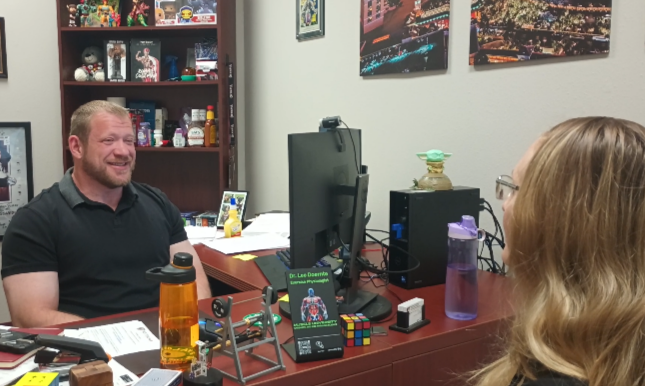Good news for parents: Overall, my take away from my conversation with Dr. Doernte is that creatine is a highly recommended supplement for adults looking to increase strength and speed in power sports and activities. I generally would not recommend it for children just based on the limited unique benefit for the cost and hassle of having to remind your kid to take it all of the time. (Let’s just master brushing teeth and getting homework done first, right?) However, if you decide to try it or have your child try it, they mostly likely will not have negative repercussions to their performance or health.
Keep reading for the details:
The proliferation of information on the internet has been both a blessing and a curse. On the one hand, any of us can be more informed than ever before on any topic. On the other hand, a lot of bro science shared by social media influencers is not necessarily vetted in the lab. So, to find out the truth about creatine and bust some creatine myths, I reached out to the expert, Dr. Lee Doernte of West Texas A&M University. Dr. Doernte completed several studies on creatine earlier this year and took a few minutes to answer some questions.
Creatine, a protein, is one of three supplements that truly work. However, just because a supplement works in a research study does not mean it is right for your body or your athletic goals. Let’s first dive into what creatine does. The primary benefit of creatine is improving exercise performance in activities requiring short bursts of high-intensity activity by enhancing muscle mass and strength.
ATP (adenosine triphosphate) is the currency of energy that your body uses. It is not stored in your body, so when you first begin to move, your body uses phosphocreatine to produce the first three to fifteen seconds of energy while the longer lasting energy systems are booting up. While regularly taking a creatine supplement, your body is saturated with phosphocreatine so that the first six seconds of energy (for the average person) are extended by a few seconds. It does not sound like much of a benefit on paper, but the increase in volume that an athlete can accomplish and the increase in one repetition maximum are evident and well documented. An increase in volume might be that a sprinter who could do six 30-meter sprints in a workout can now do nine at the same level of fatigue, or an athlete who could do three sets of five power snatch at a certain weight can now do four sets of five at the same fatigue level. The obvious result of more volume at the same level of fatigue is faster improvement in performance.
In general, creatine at recommended doses has been deemed safe. The side effects could include water retention and mild stomach issues which usually resolve themselves after about two weeks of starting the supplement.
Next, we can put a few creatine myths to rest:
- Creatine is NOT a steroid.
- Creatine is NOT bad for your kidneys.
- Creatine is NOT creatinine.
Who Should Use it:
Creatine is going to work well to enhance muscle strength in about 70% of users. One theory is that athletes who tend to be more extreme type II athletes (primarily fast twitch muscle fibers, put on muscle easily) will feel the effects of creatine less while athletes who tend to be more extreme type I athletes (reliance on slow twitch muscle fibers, great endurance, slower to put on muscle bulk) will feel the effects of creatine more. Try it for a month to see if it works for you.
Adults who participate in strength and speed sports or activities (such as weightlifting) should not feel nervous about giving creatine a try. If you are interested in creatine only for improving cognitive abilities, there are probably better options. While it has been shown to have some small cognitive benefits, there is not yet enough research out to show that the benefits are sizeable and consistent for many different types of people. On the other hand, if you are primarily interested in creatine for improving speed and strength, then feel free to enjoy any additional small cognitive benefits that come your way as well.
Pre-adolescent athletes are constantly developing and growing every single day just by showing up to practice and breathing. Creatine will not necessarily hurt them, but I do not recommend it for this age group because your time, energy, and money can be better spent on so many other things. Your child is going to be improving constantly strictly due to normal childhood development in many areas and supplements are generally unnecessary.
Teenagers, especially boys, are interested in taking creatine. Again, there is no evidence that it would harm them or harm their performance. For younger teenagers, I give the same advice as for children. As they begin puberty, they are going to have outstanding growth and improvement caused by the changes happening in their bodies. The effects of creatine may be overwhelmed in the normal effects of growing. There is one theoretical potential for increased injury in children. Typically, as the muscle develops and is able to produce more force, the tendons develop and become stronger to be able to support those forces. A sudden increase in muscle strength due to creatine usage without the parallel development of the tendons could result in unnecessary injuries. This line of reasoning has long been shown to not be a concern or cause of injury for adults (Watsford et. al., 2003), but a recent review of all literature regarding youth athletes and creatine supplementations determined that there are not enough conclusive, quality studies to definitively state the safety or efficacy of taking creatine for adolescents (Metzger et.al., 2023). Perhaps an older teenage athlete could benefit from creatine if they have been training at their sport for many years, are mostly through puberty, and have slowed down in their improvement in the sport. As a coach and a parent, I would try creatine with the small proportion of athletes who fit this description, but I would probably avoid it for others.
How To Use It:
Five grams per day, taken at any time of day, is the recommended dosage regardless of weight, age, or gender.
A 25 gram per day loading dose is commonly recommended, but you will probably be better off skipping this. For most people, the loading dosage increases the incidence and severity of side effects, but only decreases the saturation time by about two weeks. For the average creatine user, this is not worth the extra effort and cost.
According to Dr. Doernte, different types of creatine, such as creatine monohydrate or creatine ethyl ester, are all equally as effective for all practical purposes despite the claims of some heath and fitness influencers. For this reason, the average user can rest assured that buying the cheapest or most convenient version of creatine will give them essentially the same results as other options.
If you do decide to try it, let us know after one month how it worked for you, your primary sport or activity, and your age! And as always, if you want to discuss your creatine usage or anything else on your mind, contact me.
~Coach Melissa
Metzger, G. A., Minneci, P. M., Gehred, A., Day, A., & Klingele, K. E. (2023). Creatine supplementation in the pediatric and adolescent athlete– A literature review. Journal of Orthopaedics, 38, 73–78. https://doi.org/10.1016/j.jor.2023.03.010
Watsford, M. L., Murphy, A. J., Spinks, W. L., & Walshe, A. D. (2003). Creatine Supplementation and Its Effect on Musculotendinous Stiffness and Performance. Journal of Strength and Conditioning Research, 17(1), 26. https://doi.org/10.1519/1533-4287(2003)017<0026:CSAIEO>2.0.CO;2



